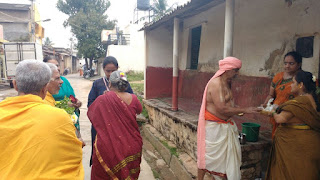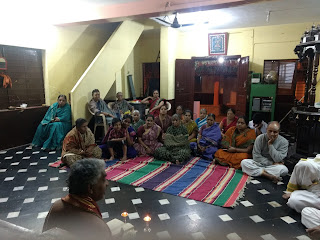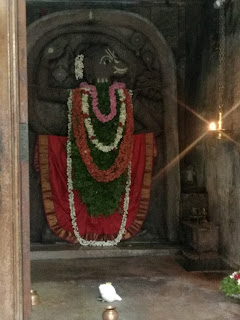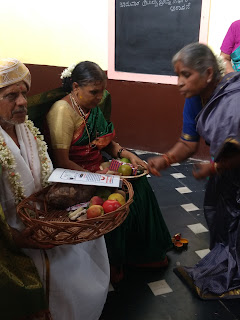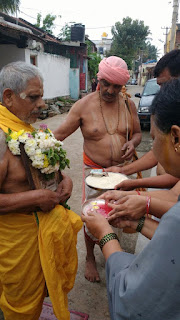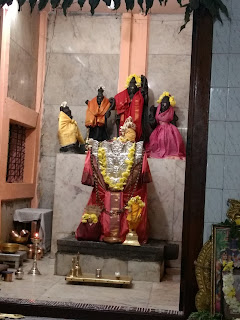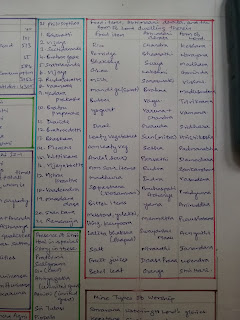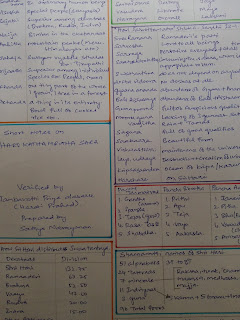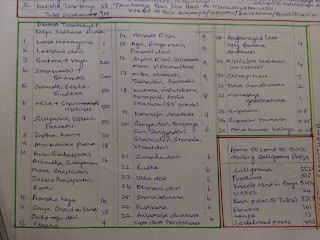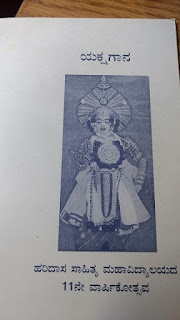Karnataka’s Yakshagaana
Book published on 01/07/2007
By Haridasa Sahitya Mahavidyalaya and Research Center
In Kannada: Harati G Prahlad
Translated in English by : Smt. Savitha Rao
Proof reading: T.V.Sathya Narayanan
***
The contribution of Karnataka’s Haridasas towards the true philosophy / knowledge (tatvavada) is commandable. They have a bigger hand in spreading the philosophical knowledge to common people. Till now it is not surprising to see that no one can challenge them in their knowledge. The reason is that, they were the patrons and followers of Sri Madhwa Siddantha.
Haridasa Sahitya is widely used as the basis for different types of art. We can experience gamaka (kavya vachana / story telling) forms in Dasa Sahitya. It is closely associated with art of dance. Dasa Sahitya holds an equal position as that of carnatic music in the field of arts. It is associated with katha kalakshaepa (story telling). Apart from these we have to notice that dasa sahitya is associated with yakshagaana form of dance.
We cannot deny the fact that the immense practice/ use of dasa sahitya in yakshagaana can be seen in Udupi District. Many haridasa’s in Udupi enriched the art of yakshagaana using their songs (krithis). The art of yakshagaana is not just dancing. It is a realistic visual demonstration. It visually reflects the essence of dasa sahitya which is nothing but bakthi towards Lord Sri Krishna through the art of performance of dance.
Even though we can find some difference between karnataka’s traditional (bharatanatyam) dance and yakshagaana, the goal seems to be the same. The traditional form of karnatic dance and music plays an important role in expressing bakthi towards The Lord. But in case of yakshagaana a combination of dance, music, dialogues and expressions through actions (visual) is used based on the theme and situation. In this way, we cannot say that yakshagaana is purely dance or purely drama, but a combination of dance, drama and music.
This type of art is happening in around places like Udupi, Mangalore, Sirsi, Dharmastala, Honnaavara, Dharwad and Manavi. Apart from India, yakshagaana dance form is also recognized in the international platform.
Who is the main person? Who worked towards the growth and development of yakshagaana? It was through Acharya Madhwa, whose birth place was Pajaka. Yakshagaana is referred by some people as ”Bayallaata”. Probably Acharya Madhwa also must have performed this art. The great saint who beautifully sang Dwadasa stotra, even today his lineage view from his place is associated with bayalaatta means, he must be an expert in this art.
In 1262, King Mummadi Veera Narasimha made SriKakulam as his capital, which belong to the Kalinga Kingdom.
From the history we come to know that the king of Kalinga was a follower of Vaishnavism. Once when Acharya Sri Madhwa visited Kalinga, the king welcomed and honoured Acharya and got initiated through him to Sri Krishna dharma or Sri Bhagavatha dharma which he started propagating further. In the royal court of Veera Narasimha, the finance ministers Swami Shastry and Shobana Batta debated with Acharya Madhwa and accepted ashrama and became his disciples. They were called by the names Narahari theertha and Padmanabha theertha respectively.
After the death of Kalinga king Banudeva, Narahari theertha had to become the kalinga king as the elephant garlanded him. He ruled the kingdom for 9 years and while handing over the kingdom back, he took the idols of Sri Ramachandra as gift, which was kept in the kindgom's treasury. We come to know that, around 1293, Narahari theertha came to Udupi and handed over the idol of Sri Rama to Acharya Madhwa. Narahari theertha has also written many devara namas and through them he propagated bakthi yoga to the people.
Narahari theertha had many disciples under him. Among them Gopalakrishna Saraswathi was his favourite disciple. Whenever Saraswathi had some free time he used to write small sanskrit plays and perform in front of Narahari theertha. We come to know that all these dramas were performed at Srikakulam (Durga) temple. On seeing these plays it is said that one man called Siddappa got enlightenment and became Siddapa yathi. It is believed that these small dramas awakened the conciousness of the people and inspired them to show bakthi towards Lord Sri Krishna.
Narahari theertha sent Siddappa to Udupi to learn vedas and natya sashtras for 20 years. After he became versatile in these subjects, he came to Srikakulam temple (Kalinga kingdom) and it is told that later he became the famous Siddendra yathi. It it believed that he wrote a devotional play called "Bhamakalapamu" and made the young Kushipudi brahmin boys to perform a dance drama for the same.
If the story narrated by Dr. Shivaramakaranta and Sri Kanakalingeshwara is true, then we can assume that Siddendra yathi was influenced by the yakshagaana and bayalaatta form of arts prevailing in South Canara during his stay in Udupi for 20 years. (Reference: Yakshagaana Bayalaatta Dr. Shivaramakaranta Page 46-47)
We come to know that Sri Narahari theertha became Archarya Madhwa's disciple around this time. Even though the purpose of sending Narahari theertha to Kalinga kingdom was to bring the Sri Rama's idol, the main intention of Sri Madhwa was to sow the seeds of Bhagavatha dharma (Sri Rama bakthi) in that region. Sri Narahari theertha completed his task and submitted the idol of Sri Rama as guru dakshina. After this Archarya Madhwa and Narahari theertha spread the Bhagavatha dharma to people like us using yakshagaana and bayallaata. Because of this reason, this form of dance became famous in and around the regions of Udupi.
Yakshagaana, Bayallatta, Bhagavatha aata, Dodda aata, Chikka aata all these words have become paryaya related words. It is not wrong if we say all these are a form of service (seva) to lord Sri Hari by means of dance (visual) performance.
The Ashta-mata swamiji's of Udupi even today give a very special importance for Bailatta Yakshagaana performance. Acharya Madhwa appointed Sri Narahari theertha to propagate this Bhagavatha sampradaya bayallaata to nearby small villages. Through Narahari theertha's efforts, Acharya Madhwa brought this art of bhagavatha dance or dasa avatara dance in practice. Even today in all ways this art is progressed well in both national and international platforms.
As the art of bayallaata spread to different regions, based on the language, environment and climatic conditions of each region, small reforms were introduced and currently there are five different forms of bayallaata as explained below.
1) In Andra Pradesh it is called as Kuchupudi dance. From early days it has been famous.
2) In Tamilnadu this Bhagavatha dance is called as Therukoothu.
3) In Maharashtra this Baillaata is called as Dasarata (or Ratanata). Meaning humour in Marathi and may be it was full of fun.
4) In Karnataka it is called as Bhagavatha maela, Bayallaata, Sannaata, Yakshagaana, Doddaatta.
5) In Kerala we can see Kathakali which is similar to Yakshagaana in which moral stories are performed.
Yakshagaana is a combination of all these 5 different forms of dances. We can find dance and dialogues used in between the performance. Songs are also sung in between. If there is song, then definitely it must have tune and rhythm. Effectively this art was performed on the stage build in the center of a field.
There are three to four different ways about how people became haridasas:
1. By profession, by taking ankita from guru and to be in lineage of their guru
2. Haridasas who have not taken any ankita.
3. If people become haridasas by profession or by lineage then there are lot of differences between them.
In this way, the efforts and credit of giving a shape and structure of an art, to this Yakshagaana Bayallaata goes to Sri Narahari theertha. From this we come to know that Sri Narahari theertha was an expert in both arts forms Yakshagaana and Gandharva gana.
Through him people of Andhra have put lot of efforts for this dance form and brought glories to Karnataka.
Narahari Theertha was the first saint (moola purusha) in Adamaaru mutt lineage. He studied all the saastras extensively under Sri Padmanabha theertha, who came to region of Hampi and achieved great heights. With the blessings of his guru and parama guru, he entered the brindhavana in a small hill in Hampi. It is believed that he gave sanyasa ashrama to Sri Jagannatha theertha. It is not suprising to say that Sri Narahari theertha is the father for the art forms of folk dances like Kuchupudi, Yakshagaana and Bayallaata.
Music, dance and dialogues are the important parts of Karnataka's Yakshagaana. It is generally performed on a stage in the middle of a field. Doddaatta or Moodalapaya as Yakshagaana is called in Karnataka is a favourite entertainment with the mass of people.
I) What is special about Doddaatta? Doddaatta is called as Moodalapaya. In this we can find all the legendary (puranas) topics discussed to a greater extent as in dasa sahitya.
In Doddaatta, there are two types performers - called as on stage actors (mummaela) and background performers (himmaela). The on stage performer will come singing on his own while entering the stage. But when a song is sung by the performers in the background, then the on stage actors will dance on the stage.
The person who is driving the play is called as the saarathi (leader). The music and the tabla will be played based on the song tunes and dance steps of this person. All the play performances will start after offering prayers to Lord Sri Ganesha. The saarathi will introduce each and every performer and their role in the play to the audience. As the saarathi is introducing the role of each performer, the performer will speak few dialogues as per his role he is going to perform in the play.
In those days they have to make arrangements for stage lights, very big oil lamps etc. for the stage performance.
A stage performance in the name of "Manoraaya" was very famous in doddaata.
II) Sannaata: A type of yakshagaana which was invented and developed to spread the faith of saivism and vaishnavism. As per the opinion of great pandits of present days, this type of dance was first started in and around Belagavi district. In this type of dance there were some formulas (calculations) used which was controlled by the performer. In olden days this type of dance was called as "Dappinaata". In 19th century "Patara Mastara" was a very famous artist who was the founder of the dance form called "Sankyabaalya". It is really a rare visual treat, as its dance steps are in the style of yakshagaana folk dance.
III) Paarijata Aata: The Paarijata aata which is a form of Sannaata, was called as Sri Krishna Paarijata aata by the vaishnava sect. In this, the story writer and the people who perform the different roles (dance) are called as "Idduta".
As explained before this type of dance also start with prayers to Lord Vinayaka. Along with the people who play the music (drums) in the background there are two singers. There is a custom of introducing the "Iddutis" who are going to perform a role in the dance. In between the play, a mixture of traditional and innovative songs are sung by the on stage performers.
Mostly, while presenting purana (legendary) stories the role of rakshasa is just like this. In sannaata a lot of importance is given to the role of a rakshasa. The reason being, instead of assuming the appearance of the negative character, when see a visual presentation it is quite common to have all type of feelings like excitment, fear etc.
As per the researchers and artists it is really a very great treat/fun to watch these negative characters on the stage with the costumes, the ornaments and a strange sound made, along with many lights shown to brigthen up the character and stage and thus prompting the appearance of an evil person (rakshasa) on the stage.
Whatever it is, how much ever worse the bad people behave, to take care of their destruction there is always the ever independent Paramatma. Lot of effort and importance is given to present the Paramatma on the stage. We are not wrong if we say that in most of the bayalaata dance forms this remains as the common objective or mission.
Yakshagaana is a humble art which gives the needed potential for the human beings to lead a life, it is in our hands and our duty to protect and develop this art further. Probably it is my duty I feel. We can see that the deep compositions (songs) which haridasas have written was just written for the sake of yakshagaana. The kruthis (songs) written by them play a very important role in this bayalaata. There is devotion in this. It awakens the spiritual feeling (bakthi) among the people. This the reason dasa sahitya plays a foremost and an important role in yakshagaana.
The culture and heritage department of Karanataka's government, many other associations and many other great artists are working very hard day and night to retain this art. For example we can say that there are many in this 20th century who has campaingned from behind the screens.
1) Dr. Kocha Sivaramakarantaru
2) Prof Ku. Shi. Haridasabattaru
3) Prof H. Krishnabattaru like this we can name them.
4) Manipal association, Paibandugala association, Karavalli association and other groups.
5) The central Academy of Music and dance are conducting courses in gurukula style.
The head of Sri Vadiraja mutt, Sri Vishwotama theertha has sponsored the training of more than 300 students. It is really a matter to be proud of and we can call it as a milestone achieved.
In order to retain this art, the pupils of Sri Vadiraja mutt, who were staying in Udupi's Sri Adamaru Mutt have religiously established "Sivaprabaala Samuchaya" in Hayagreevanagar of Udupi district. Here there is central union office, library, museum, practice (lesson) hall, sabha hall, kitchen, students living room, guests room etc. like this the place was developed to greater heights.
Inspired by the kruthis (songs) of Purandaradasa the art of yakshagaana became dear to the King of Tanjore in Tamilnadu, which is the foremost place for patronage of music and arts. The King encouraged its further development to a greater extent. Like this Mummadi Krishnaraja Wodeyar, Lingaraj and other poets like Muddanna who have enjoyed the essence of this art and thus the lineage of this humble art can be called as an existing working/existing art.
This art helps to express our love towards the Paramatma. Even after 500 years have passed, this art is still lively and exists in the present time. The most respectful Sri Madhwacharya's interest, further developed by Sri Narahari theertha and then with the encouragement of Sri Vadiraja, the art of yakshagaana provides a great feast for the audience.
Haridasas compositions can be beautifully sung in form of keerthana(song), their ugaabhogas are splendid to listen to. Apart from this, it is the greatness of haridasa sahitya that yakshagaana has grown to this extent in the profession of stage peformance without any preassumption like, for this art this is the music composition (dasa sahitya).
If we have to retain this art, we need bhagavatas who could sing very nicely and who are easily accessible. On the other hand, the related government, government organizations, researchers should pay attention to open an insititution which will train and develop such bhagavathas.
In the Universities of Udupi, Hampi if we open departments for training this art then we would achieve a greater development for it. Whatever be the form of art its creation and extinction is time bound. It is also important people who are curios must encourage and support from their side. These also give boost and help in development of this art.
As described before Parijata atta is very important for yakshagaana. All the credits goes to Gokaavi Anantaacharya who estabilished this sahitya. His Venkatesha Parijata play is very famous. It is matter of pride to know that, he is a poet who lived one and half centuries before from 1776 till 1840 who created this kaavya in the style of folk dance. Initially this art got popular in places like Belagavi, Bagalkot, Miraj, Vijayapura, Kohlapur and then it spread to other locations at national level - this is what the researches think.
From the inspiration taken from Timmanna kaavya, Anantadesharu combined Srimad Bhagavatham's Sri Krishna's history and Sri Madhwacharya's dwadasha stotra and created Sri Krishna's Charitra thus taking all the credit for bringing Sri Krishna's story on the stage.
After this
1) Hanumadilaasa Tippanacharya's Kruthi (song)
2) Kuchaelo Upakyana
3) Kaalinga Mardhana
many creations were released. We can call them as creations of yakshagaana.
More about Gokavi Anantadeshyaru: When dasaru established Venkatesha kalyana, this creation became a great poem with 1000 stanzas in it.
This work has 10 episodes.
The Lord of Vaikunta, Sri Srinivasa adorned the costume of kirataka (hunter), took permission from his mother Baguladevi and set off for hunting. On the way in the royal garden of Akaasha Raja, he met Vanajakshi in the garden and spoke as if he has come to their house, this is told by Purandara Dasa.
The dialogues written by Anantadeesharu, for the conversation between Padmavathi and Srinivasa are really romantic. This is a very important episode in the whole of this creation. We also understand that he impressed the audience by describing the events one after the other through marvellous scenes which was a wonderful visual treat. Along with this a steadfast bakthi also developed comfortably.
Yakshagaana is also called as King of Bayallaata, because it awakened the interests of people in kaavyas and cooled (entertained) more than hundereds of common men. Through this it was possible to stimulate bakthi in common people.
Around 150 years ago bayallaata was established following the same style of yakshagaana in and around Raichur District. But it did not become that famous among people like yakshagaana.
All the plots (stories) told in yakshagaana are based on haridasa sahitya. Sri Rama Paaduka Pattabhisheka, Kanakaangi Kalyana, Chandarahasa Katha, Prabhavathi Parinaya, Draupadi Samvadha, Bharathata Katha, Ramba vilasa, Shabharasankara vilasa, Shruthakeerthi Rajana Katha, Rukmangadha Charitrae etc. were famous bayallaata.
There are so many song pharses left by haridasas which aptly suits yakshagaana performance. It is our responsibility to protect and nurture this art for the future.
In the name of Parijata Aatta there are more than hundreds of literature available as per the opinon of the researchers, few of them have been mentioned below.
1) Venkatesha Parijata - Gokaavi Anantadeesharu
2) Panduranga Parijata - Jagannatha Dasaru
3) Venkatesha Parijata - Gopala Dasaru
4) Srihanumad Parijata - Vijaya Prabugalu
5) Geeta Parijata - Sri Vyasa theertharu
Like this we can keep on listing them.
In all these types of bayallaata, apart from propogating / spreading knowledge about Lord Sri Krishna, there is also the intention to spread the tatvavadha principles established by Sri Madhwacharya.
As per the opinion of many research scholars there are more than 400 episodes in yakshagaana. Out of them around 100 episodes are published and available in book form. Few are available on palm leaves and as manuscripts. Few more are available in the minds of the people who sing those songs for generations.
As per the statistics collected, even today we can find experienced artists among us who can sing 30 to 40 episodes at a time. Among them Mohini Basmaasura, Indrajith kaalaka, Devi Mahatme, Babbhruvahana, Abimanyu Kaalaga, Daana Soora Karna, Saidamvavadhae, Krishnaarjuna Kaalaga etc. can be named as famous performances among people.
Let us look into the important aspects of yakshagaana:
1) Really exciting (spendid) to watch the decrorative and elaborate costumes.
2) The most important part is to display the essence of the literature through Abinaya (body/face expression), charimandala (stage organization), karamudhrae (hand symbols) and rochakagalinda (thrilling noise/voices)
3) A famous village folk dance because it was spread by Sri Narahari theertha in these regions.
4) By the inspiration of Purandara Dasa's kruthis, it resembles the style of village folk dance.
5) Bhagavathas sing the songs, it is our responsibility to train such bhagavathas so that they can sing for the programs. The government organizations and associations must turn their attention in bringing up such bhagavathas who could sing. This definitely helps in retaining this art.
6) In this way, we have to protect and retain this art by considering it as our responsibility. We must retain this art naturally as orginated in this country and belongs to this country. We must not treat this art as an alien from of art and just perform for an exotic display in foreign land or in front of foreign people.
7) The different team players of this art like people who play the drums, beats and other fine musical instruments, professional stage artists and other artists should develop their skills in Haridasa Sahitya without any hesitation. This is the only valuable and perfect way to sustain art.
8) In carnatic music the influence of gamaka alankara (decorated musical notes) style is more. In yakshagaana, more importance is given to design of rhythm (Laya) and thala (musical meter). This style is orchestrated mainly for the musical instruments band and the dance steps of the performance.
9) Yakshagaana which is in the style of folk dance, has the capacity to awaken the society. Like this it has found a great place, as one among the best in the beautiful art forms.
10) Udupi's national poet’s, Govinda Pai Research centre ( a part of MGM College Global Organisation), has been founded in Udupi itself to develop this yakshagaana. This came to existence in the year 1971.
11. a) Shivapraba Kala Samuchaya, Hayagreevanagara, Udupi, one of the kala bhavana founded by Sode Sri Vadiraja mutt. Apart from this there are small organisations like
b) Mandarthimaarana Katte, Kamalashelae Amrutheshwari Savagooru these two organizations (teams) have been recognised well.
c) Kateel and Dharmastala are very famous teams in Thengutittu.
d) Karnataka's yakshagaana Sabha
e) Mangaladevi yakshagaana Mandali
f) Central Manjunatheswara Team are few notable organisations.
There is a very close relationship between yakshagaana and dasa sahitya. We must be proud that the very purpose of dasarayas (devotion towards Lord Sri Krishna) has reached in each and every village through this yakshagaana. It readily came in hand to express devotion.
The auspicious (punya purana) stories from the famous works which are related to Sri Hari like Ramayana, Bhagavatha, Mahabharata, 18 puranas, many upanishads form the basis for haridasa sahitya. With the impact of this energy, even after 500 years have passed the haridasa sahitya has been in existence till date without diminishing its fervor. There is no dispute in saying that if dasa sahitya is a living art of the present day. Similarly, yakshagaana is also a living art of the present day.
We can further say that it had the blessings of Archarya Madhwa who is the 22nd philosopher. After that Sri Nahari theertha has further developed this yakshagaana. Sri Vadiraja who came after him, has written the songs by himself and danced to its tunes. Like this yakshagaana has an excellent traditional history.
Sripadaraja's ankita is RangaVittala, from the love towards the same RangaVittala, I was inspired to write four lines like this. From this we wish that this art is further developed. When I was studying my M.A. (Kannada), there was this parijata song (kruthi) for 20 points. Except for this I could not appreciate any other literature in that course. This is the time when I got some knowledge about yakshagaana.
Once while travelling back from Sodhe to Sirsi, near the bus stand preparations were going on for staging yakshagaana. The show was about to start by 8, our bus was at 10.30, thinking that we have time to watch the show, after a long wait the show started with prayers to Lord Ganapathy. The curtains were raised, just then our bus started towards Bengaluru. Around 1965-66 one troup staged the same performance in our place. That time I was not that much interested in it. I have watched 3 to 4 episodes in the TV that's all. I would have watched one program in Vidyapeeta Bengaluru.
Yakshagaana is generally performed during night time.The sound from the Chenda drums (nagaari) is fantastic and cool. The bronze voice of the bhagavathas who sing, plays an important role. Kantikaara Seshagiri Bhagavatharu in the past has stamped his name in this art. Karaavali's Yatheeswara, by chanting and remembering the God's name (devara namasmaranae) all the time and through this yakshagaana, he was known to always perform great service to the Lord.
Acharya Madhwa has proved and taught us that only through devotion (bakthi) we can attain salvation (mukthi). "Amala bakthischa tat sadhanam" following these words expression of stable bakthi became the prologue and important part in the structure of yakshagaana. Inspite of all these there was no exaggeration or significance given for bhagavathas. But we can find many learned scholars in Tamilnadu region who are called as bhagavathas.
1)Around 1684, the Tanjavur rulers who belonged to bhosle dynasty has encouraged this art.
2)Around 1728-1736, Tulajaji was a very famous muscian, profession singer, drama artist. He wrote a sanskrit literature called "Sangeeta Saraamrutha". He has proclaimed that Sri Vyasarajru is guiding him from his mind.
3)Around 1669-1734, in the royal court of King Raghunayaka, Govinda Deekshitar was a bhagavathar of great importance. He wrote a lot of literature and attained fame. He has written a folk play called "Sangeetha Sudha" and has dedicated this work to the king.
4) There is no doubt in stating that the creation of yakshagaana was a great arrangement to describe the glories of Lord Vishnu and in line to show our love and bakthi towards Him.
5) As per the region wise differences, they call it like 1) Moodalpaya Yakshagaana 2) Paduvalapaya Yakshagaana 3) Bayalaata/ Bayalu Nataka or Dasaavatara Atta.
6) In the 20th century, Yakshagaana was recognised and respected by the artists and scholars of different fields due to the efforts of a great respected person, a great thinker Dr.Sivarama Karantakaru. Earlier it was recognised as "village or country side art".
It is very important to express the emotions in yakshagaana. Yakshagaana is branch of folk songs (which has been passed over generations through mouth with some principles).
The raagas used are
Kedaragowla, Kambhoji, Khamaj Hamsadhwani, Ataana, Aarabi, Devagandhara, Kedaragowla,Punaagavaraali, Shahana, Nadanaamaakriya, Sindhubairavi. Aahiri, Mukhari, Saaranga hindustani, Saaranga Bhehag, Thodi, Varaali, Sama Dhanyasi, Neelambari, Kaapi, Mohana, Bilahari we can see that all these raagas were used to express the emotions of Shringara (love/beauty), Haasya(laughter), Karuna (sorrow), Raudra (anger), Veera ( heroism/courage), Bhayanaka (terror/fear), Bibhatsya (disgust), Adbutha (surprise/wonder), and Shantha (peace or tranquility), bakthi in form of parental affection and rejoicement.
Dr. K.M. Raghavan Nambiar has written his research thesis in yakshagaana.
What has to happen to yakshagaana?
1) Yakshagaana must be performed by the people making sure that it supports haridasa sahitya.
2) In the opinion of the poets, it must be recognised as Hanumad Vilasa Yakshagaana on the stage.
3) They must use haridasa creations (krithis) like Chandrahasa charitre, Seetha swayamwara, Gajendra Moksha, Shankara Gowdana haadu, Giriyamma's Uddalika Kathae.
4) yakshagaana art must be lovingly put in practice by people.
Apart from these Sri Vadiraja's Lakshmi Shobhane, Vaikunta varnanae, Kanakadasa's Mohana Tarangini, Sripadaraja's Bhramarageetha, Mohanadasaru's Koolu song, Kumaravyasa's many episodes related to Mahabharata, Purandara Dasa's Sudhama Charitrae, Gajendra Moksha, Draupadi's vastrabharana, like Satish Kaedlaya more than 100 people must be trained. It is also required to train people who perform during festivals, in the elements of dress, costume and story in such a way that while introducing modern concepts, we do not destory the roots of this art culture.
The aspects of social concern, social discipline, behavior, understanding which are found in dasara padas (songs) must be used in the yakshagaana. Through this we can awaken the people in the society. The life of haridasas, their achievements, their teachings if it has to be brought to light through yakshagaana, then the resourceful and unknown palm leaves and manuscripts have to be brought to light. We have to further think and research on this topic.
Paaliso Pandari purireya paavana kaaya
beemarathi kula nilaya paaliso pundarikaayaa
Sri Jagannathadasar in his Panduranga parijatha, starts with the above lines and continues like...
Tharuna thulasi maalaa
thappa kaangeyasela
sharadhi thanaya lolaa
shakvari kaaripaalaa
sri ajabava maalaa
suddha kaarunyaleelaa
purahara suba leela
paahi gopala baala
Dasaru explains the scene when he had darshan of Lord Panduranga. In the 9 stanzas, Dasaru sings like this - He who lives in Pandaripuram, has pure body, lives in Bhimarathi river bank, one who made Pandaripura as his place, He is the reason for all the Living beings, He is the one who saves all the Gopalakas. This song is made especially for the yakshagaana.
The following stanzas are from Hanumadvilasa recited by Thippannarya.
While Ravanan speaks to Hanuman he tells these words:
Neenaarai Vaanara veerane
maunavethake nudi - rana soorane
maha dheerane - gorakaarane (pallavi)
Ellindha nadethanthe, illigethakke bandhe
illindha payaNavellige mundhe
Ethake nindhe, dhaityara kondhe
ballidhanu neenadhadaprathi
mallanaadhemi indhrajiththanna
hullu baanakkaagi silukidhe
kshulakana pari nimishamoothrath ||1
iruvudhava dhesa dharaniyolu elli nivesa
sharathiyanendhu dhandidha kesha
purahara srisha bramma suresha
garuda mukhyaru pogalariyare
purava navandhadhali pokkalu
thirukipoge samartha indhrahe
maruhanaadheyo marula dharalane ||2
Later in the song...
vanara norvana pididhu valavanu vai
shvanakanindha uruhi puradholagedha
shanana meresuvanendhu thrijadiyolu
dhaana viyorvalu suruthiraladha keli
janaki chinthisivanhi sukthava nija
manasadhalli dhyanadha maadala nilana
soonu santhanalipppa dheha naagudhapara
manandha saandhranaagudha muppurakalane
shananuruhithandhe bakthikandana pura
hinalangkaarava maadi neeradhiyolu
snaanava maadi bega - seethadevi
enadhalenutha laaga - chithisi, bandhu
maanini maneyaraagi nidhvathi kandu
thanalankeya shikikahuthiyanithu
vainavellava thiluhivanu ga
threenyai simhana dheesa maruthi ||
This song being a Ragamalika, when performed in yakshagaana, will be delightful to listen and to watch also.
The songs like this and many more which are not so popular among people, should come out and be performed in the stages. This is my wish to Lord Sri Hari.
Sri Krishnarpanamasthu
